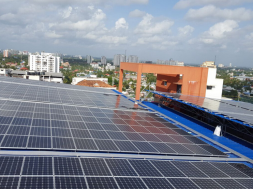
India’s utilities are under enormous pressure: the capacity of renewable energy sources is growing with solar prices dropping below ₹2.5/unit while the demand has not improved. All this does not seem to upset Prashant Jain, who was recently appointed Joint MD and CEO of JSW Energy, despite almost one third of the company’s 3,140 MW thermal capacity is not tied-up with long-term PPAs. In an interview with BusinessLine, Jain shares his vision for the industry and explains how JSW plans to survive the disruption.
Analysts’ outlook towards the thermal sector is not quite encouraging. What keeps you positive?
You will see the challenges continue for around 18-24 months until the demand and supply situation gets corrected. The industrial demand has not picked up for the last five years, there is a lot of consolidation that has been happening in other sectors and slowly overcapacity is getting utilised. So, I believe that industrial demand will pick up. Also, the government is putting special focus on low-income housing and that will be propping up electricity demand in the next two-five years. Electrical mobility (for example e-vehicles) is the third dimension that will contribute to demand as this is both global trend and government thrust.
But even if demand profile improves, with renewable energy capacity growing, what is the future for the thermal sector?
The Central Electricity Authority and NITI Aayog have put the power demand growth at 5-5.5 per cent CAGR in the next five-year plan.
I feel we may be positively surprised to see even bigger growth than this because of the lower base effect. Even if it is 5 per cent, your current demand (that is 157 GW on an average basis) will go to 215-220 GW. So you are talking about an additional 65-70 GW of power demand created by 2022.
With the government’s focus on renewable energy, the current renewable capacity of 57 GW will go to 175 GW by 2022 and I genuinely believe that will happen because if earlier we were talking about environmental footprint, now it is economic rational.
In the thermal sector, the plant load factor (PLF) that has gone down will start picking up. Now thermal plants are running at an all-time low PLF of 54 per cent as against the Central government plants’ PLF of 72 per cent.
This 54 per cent might go up to 65-70 per cent, considering there is no additional capacity. Also, the stranded capacity will get consolidated in the next two-five years. When the power demand is created, the short-term prices will improve and state Discoms will come for the PPAs.
Five-10 years down the line, as soon as the storage solution is economically viable, it will get integrated with solar system, then you will get to see a lot of grid management.
Power consumption habits will have to change.
Today night load is very less, so Discoms give power to farmers because it is low-cost power.
So, farmers get up in the night and run it till 5 am in the morning. This will change because low cost power will be available in the day-time.
Will thermal power tariffs be able to compete with the renewable tariffs?
We will see a new normal for power prices at ₹2.75-3 per unit.
So only power plants that are efficient and can produce power at this price, will survive, others will not. A lot of power plants that have been built at higher capacity will have to write-off their equity and debt, so the lenders will have to take a lot of haircuts.
Is JSW Energy capacity fitting in the ₹3 tariff scenario? And what are the growth areas for the company in future?
I believe in the next 3-4 years our existing capacity will be completely tied-up with long-term PPAs. And we are already working on PPAs at lowest possible tariffs.
Our two hydro assets are generating low-cost power — below ₹3 per unit. If we get similar opportunity to take over these kind of assets, we will be keen.
We are future ready for consolidation — as and when any opportunity comes our way where we can capitalise at the right place and the right value and where I can supply power at the new normal of ₹2.5/unit. Another growth vector is grid management and energy storage sectors — we feel that’s a huge opportunity which will be the future of this industry.















